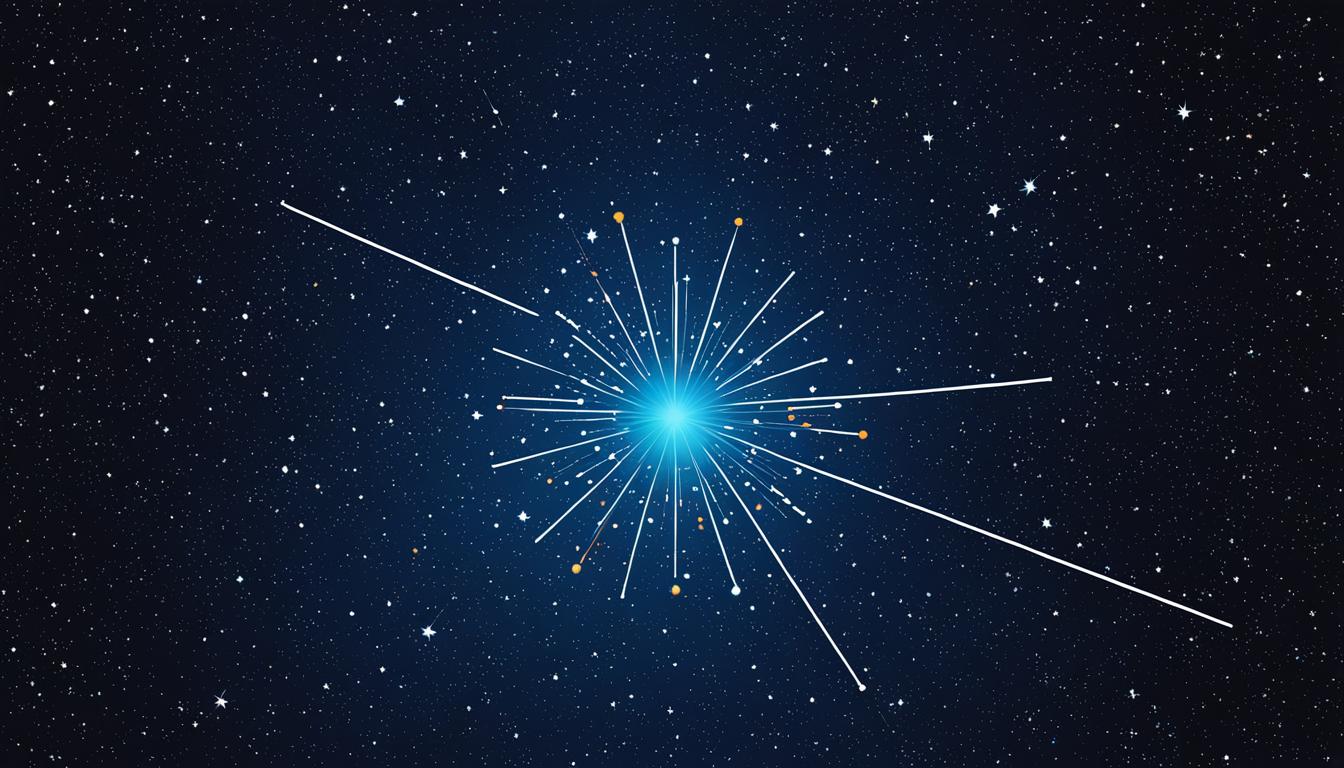Embark on a celestial journey as you uncover the wonders of Spica’s Spanker asterism. This quadrilateral formation, often likened to the billowing spanker sail of a ship, beckons star gazing enthusiasts to explore one of the sky’s most enchanting patterns. Nestled near Spica, the prominent 16th brightest star, this stellar formation is a celestial marvel that captures the imagination and serves as a guide to deeper cosmic discovery.
As the stars of Corvus constellation delineate the edges of this navigational masterpiece, Spica’s Spanker stands as a testament to the awe-inspiring beauty inherent in the cosmos. Whether you’re a seasoned astronomer or a casual observer, this guide throws open the heavens, inviting you on an odyssey through the stellar formation that has guided mankind through ages.
Key Takeaways
- Discover the distinctive Sail-like asterism known as Spica’s Spanker, a gateway to astronomical wonders.
- Delight in star gazing this celestial marvel featuring prominently in Virgo’s celestial neighborhood.
- Learn how to navigate to other celestial objects using this stellar formation as an ancient mariner’s compass.
- Appreciate the fusion of natural splendor and cosmic orientation embodied by the Spica’s Spanker asterism.
- Unravel the storied history behind these stars, from their astral choreography to their significance across cultures.
- Embrace the dual role of Spica’s Spanker as both a stunning stellar formation and an instrumental guide in celestial navigation.
Unveiling Spica’s Spanker Asterism in the Night Sky
If you’ve ever gazed above on a clear evening, chances are you’ve witnessed an array of sparkling celestial objects that have etched patterns across the night sky. One such configuration that captures the imaginations of star gazers is the Spica’s Spanker asterism. Referenced often in astronomical texts, this pattern is not just a wonder to behold but also a compass for navigating the cosmos.
For those looking to observe this fascinating astronomical phenomenon, your quest begins with the star Spica. As part of the asterism, Spica is one of the most prominent stars in our night sky, boasting a brightness that makes it unmissable once you know where to look. To pinpoint Spica, let the arc of the Big Dipper’s handle in the constellation Ursa Major be your guide, trace it to Arcturus in Boötes, and then slide across to Spica, the gem of Virgo.
Positioned southwest of Spica, the stars forming the asterism—Gienah, Kraz, Algorab, and Minkar—stand out against the less populated stellar backdrop. These stars act as celestial signposts, pointing out a star cluster and other significant sights, such as the splendid Sombrero Galaxy and the entwined Antennae Galaxies, providing a gateway to deeper cosmic wonders.
- The Sombrero Galaxy is a spiral galaxy located 5.55 degrees east of Eta Corvi, and it serves as a pristine example of a galaxy with a prominent bulge and dust lane.
- The Messier 68 star cluster, discovered by Charles Messier, is an elliptical globe of stars found 3.5 degrees south of Kraz, offering a visual treat for those with telescopes.
- The engaging Antennae Galaxies, located within the asterism, present a potential preview of the destiny awaiting our own Milky Way as it continues its slow dance towards the Andromeda Galaxy.
Armed with a telescope or even binoculars, you’re well-equipped to begin your stargazing journey. Remember: these celestial markers will enhance your knowledge of the night sky and guide you to observe extraordinary astronomical phenomena. So, as night falls and the stars begin to twinkle, set your sights on Spica’s Spanker asterism and uncover the secrets it holds.
Essential Tips for Locating Spica’s Spanker Asterism
Embark on a fascinating journey to uncover the celestial marvel known as Spica’s Spanker. By understanding the astronomical phenomena and star formations in the sky, you’ll improve your skills in locating asterisms—a fundamental part of the stargazing experience. Mastering these tips will not only boost your knowledge of stellar classification but will also enhance your ability to observe celestial objects with greater precision.
Guidance from the Big Dipper to Spica
The Big Dipper’s unmistakable configuration serves as an excellent guidepost in your celestial navigation. Its handle’s arc gracefully sweeps toward Arcturus, a beacon in the sky to steer your gaze toward Spica. This natural pathway lights up the sky, leading you directly to the captivating outline of Spica’s Spanker Asterism, sitting discreetly southwest of Spica itself.
Using Corvus’ Brightest Stars as a Map
To further refine your locating techniques, consider the brightest stars within the Corvus constellation—Gienah and Algorab. These stars form a cosmic map that points stargazers in the direction of Spica. With this method, not only will you find Spica’s Spanker with ease, but you’ll also gain insight into the methods of ancient astronomers who relied heavily on asterisms for orientation.
Optimal Season and Time for Observation
When planning to embark on the rewarding activity of stargazing, timing is key. To obtain a crystal-clear view of Spica’s Spanker, aim for observation during the spring months. This is the ideal season as the asterism ascends in the night sky, providing a perfect vantage point and making it an excellent opportunity to behold the wonders above.
Below is an optimal observational guide tailored for stargazers seeking Spica’s Spanker:
| Month | Observational Tips | Visibility Conditions |
|---|---|---|
| March – May | High elevation in early evening; look southwest of Spica after dusk | Clearest night skies due to reduced atmospheric disturbance |
| June – August | Possible viewing, but available observation time decreases as season progresses | Increasing humidity can hinder visibility, advantageous to observe just after sunset |
| September – February | Spica’s Spanker descends, becomes difficult to observe | Winter climates can obscure visibility due to weather conditions |
Embedding critical points of stellar navigation into your pursuits will ensure a richer stargazing experience. By following these steps to locate Spica’s Spanker Asterism, you’re on your way to witnessing a magnificent astronomical phenomenon—the very essence of astronomy.
Navigating Celestial Objects with Spica’s Spanker Asterism
As you venture into the realm of celestial navigation, you’ll find that the Spica’s Spanker asterism is more than just a stunning array of stars; it’s a crucial tool in the sky for deep space exploration. Its unique pattern serves as an excellent guidepost for stargazers and astronomers alike.

Navigating towards distant deep sky objects can be simplified with this asterism. For example, should you wish to observe the Sombrero Galaxy, simply track eastward from Algorab, or northwest from Spica to find your celestial spectacle. In a similar vein, the globular cluster Messier 68 is revealed as you journey south from the luminary Kraz.
The asterism also highlights the fascinating Antennae Galaxies, a pair of interacting galaxies that provide a captivating view. Below is a table that showcases how the Spica’s Spanker asterism anchors your journey through the night sky, guiding you to these celestial treasures.
| Celestial Object | Direction from Asterism | Object Type |
|---|---|---|
| Sombrero Galaxy (M104) | Eastward from Algorab | Spiral Galaxy |
| Globular Cluster (M68) | South from Kraz | Globular Cluster |
| Antennae Galaxies (NGC 4038/NGC 4039) | Nearby within Asterism | Interacting Galaxies |
This star gazing guide is enhanced by Spica’s Spanker, as it offers a straightforward and reliable method to witness the vastness of our universe. Whether it’s your first time tracing the cosmos with your eyes or you’re a seasoned observer, this asterism brings the heavens a little closer to home.
Understanding the Stars of the Spicas Spanker Asterism
As you gaze into the night sky, the stars of Spica’s Spanker asterism offer a celestial spectacle, each with unique properties and storied backgrounds. These luminaries have been a beacon of wonder for astronomy enthusiasts and serve as key references in stellar classification and star clusters. Delve with us into the mysteries of Gienah, Kraz, Algorab, and Minkar, which form this iconic asterism.
Gienah: A Radiant Beacon in Corvus
Gienah, glittering from its vantage point in the Corvus constellation, serves as both a guide star and a benchmark in stellar classification. This blue giant has captivated observers with its bright and consistent presence in Spica’s Spanker asterism. Positioned 154 light-years from Earth, Gienah’s significant magnitude of 2.585 makes it a standout member of this celestial group. Its spectral class B8 III denotes a mature stage in its life cycle, and its distant red or orange dwarf companion whispers promises of binary star secrets.

Kraz: The Yellow Bright Giant
The bright yellow giant Kraz gleams from 146 light-years away, contributing a yellowish hue to the asterism’s palette. Belonging to the G5 II spectral class, it introduces variability with its changing brightness that challenges star gazers to detect its subtle shifts. Its stately slow rotation is a rhythm set against the backdrop of other more swiftly spinning stars within the asterism.
The Swift-Spinning Algorab
Not to be outdone, Algorab demonstrates its swiftness with a rapid spin that sets it apart from its celestial neighbors. Just 86.9 light-years from our solar system, this white subgiant transitions through stellar evolution, inviting discussions over its current state—is it an evolved subgiant, or is it an energetic younger star approaching the main sequence? Its place in Spica’s Spanker asterism is undeniably crucial, offering spectacular insights into the dynamic processes of star formation.
Minkar: The Beak of the Crow
The red giant Minkar, aptly named for its position marking the “beak” of the celestial Corvus, is the furthest flung of this stellar quartet at 318 light-years. With a magnitude of 3.024, Minkar’s ruddy glow enriches the asterism’s narrative, serving as a beacon amidst the darkness. Its placement in the grander celestial sphere brings the tapestry of Spica’s Spanker into focus, highlighting its role in celestial navigation and enriching our understanding of the immense diversity found in space.
| Star | Magnitude | Distance (light-years) | Spectral Class | Role in Asterism |
|---|---|---|---|---|
| Gienah | 2.585 | 154 | B8 III | Guiding Star |
| Kraz | Variable | 146 | G5 II | Brightness Beacon |
| Algorab | Variable | 86.9 | A0 IV-V | Indicator of Stellar Evolution |
| Minkar | 3.024 | 318 | K3 III | Navigational Reference |
In conclusion, the diverse characteristics of the stars within Spica’s Spanker asterism fascinate and guide us. Their combined brilliance and individual uniqueness offer unrivaled opportunities for observation and study, solidifying their position as celestial gems in the study of stellar classification and navigation through the cosmos.
Astronomical Significance of Asterisms in Star Gazing
As you embark on a journey of star gazing, it is hard to overstate the role asterisms play in the grand tapestry of the night sky. These star patterns, which include the recognized Spica’s Spanker asterism, offer more than just a visual spectacle; they are fundamental to the time-honored practice of astronomical navigation. These beacons of the night aid enthusiasts and experts alike in pinpointing various celestial objects, creating an interconnected map of the heavens.
The beauty of asterisms lies in their simplicity and visibility. With no need for complex telescopes, these patterns are often discernible to the naked eye, turning any nighttime outing into an opportunity for discovery. Imagine standing under the star-studded sky and effortlessly tracing the lines between stars to find your way from Spica’s Spanker to other distant galaxies or neighboring cosmic wonders.
- Asterisms serve as celestial signposts.
- Spica’s Spanker is perfect for beginners and aficionados of star gazing.
- Historical significance enriches the star gazing experience.
- Asterisms contribute to the legacy and education of astronomical navigation.
The wonder of star patterns is not limited to their aesthetics; they are steeped in history and culture. The Spica’s Spanker asterism, among others, has guided humanity across oceans and has been used to teach celestial navigation for generations. Today, it not only guides but also invites you to ponder over mysteries of the cosmos and humanity’s place within it.
Spica’s Spanker’s Connection to Global Astronomy Heritage
As you explore the celestial highways, you’ll find that Spica’s Spanker asterism is more than just a grouping of stars; it’s a bridge between our night sky and the astronomical tapestry of cultures far and wide. This collective of stars has been steering the curious and the scholarly through celestial navigation, diving deep into the mysteries the cosmos presents. Its roots are entrenched in global astronomy heritage, making it a quintessential piece in the vast puzzle of stellar exploration.
The Asterism’s Role in Chinese Astronomy
Within the expansive sky, Spica’s Spanker attains a notable position in Chinese astronomy, revered as the Chariot asterism. This formation aligns with the Vermilion Bird of the South, one of the four mythological creatures in Chinese constellations. The stories stitched into these stars convey the profundity of cultural heritage, exhibiting how celestial bodies have guided civilizations through not just space, but time.
Spica’s Spanker Versus the Sail: Variations in Nomenclature
The narrative of Spica’s Spanker reaches across continents, varying in name and shape among societies. Known also as the Sail, this variance in nomenclature exemplifies the diversity and adaptability of star-pattern recognition, contributing to a richer, more dynamic global astronomy heritage. These patterns in the night sky serve as enduring conduits, connecting you to an ancestry that prized the art of story-telling through stellar formations. The enduring allure of Spica’s Spanker asserts the power of these astral curiosities to transcend the ages, fostering a shared celestial culture that continues to captivate observers around the world.
FAQ
What constitutes Spica’s Spanker Asterism?
Spica’s Spanker Asterism is formed by four main stars: Gienah, Kraz, Algorab, and Minkar. It features a distinctive sail-like shape situated near Spica, a prominent star in the constellation of Virgo.
How can you locate the Spica’s Spanker Asterism in the night sky?
You can locate the Spica’s Spanker Asterism by finding Spica, the brightest star in Virgo. From there, identify the four stars southwest of Spica that form the asterism: Gienah, Kraz, Algorab, and Minkar.
What is the best time of year to observe Spica’s Spanker Asterism?
The best time to observe Spica’s Spanker Asterism is during the spring months when it is higher in the evening sky and provides optimal visibility for star gazing.
Can Spica’s Spanker Asterism help locate other celestial objects?
Yes, Spica’s Spanker Asterism can help locate other deep sky objects such as the Sombrero Galaxy (East of Algorab) and the Antennae Galaxies, as well as the globular cluster Messier 68 (South of Kraz).
What is the difference between an asterism and a constellation?
An asterism is a recognizable pattern or group of stars, often forming part of one or more constellations, but without official boundaries. A constellation, on the other hand, is a formally recognized area of the sky with defined borders.
Why are asterisms like Spica’s Spanker significant in astronomy?
Asterisms like Spica’s Spanker are significant in astronomy because they serve as navigational markers to help identify and locate celestial objects. They also provide insight into star formation and stellar classification, enhancing the experience of star gazing.
What is the cultural significance of Spica’s Spanker Asterism?
Spica’s Spanker Asterism holds cultural significance in different societies, particularly in Chinese astronomy, where it is part of the Chariot asterism associated with the Vermilion Bird of the South. It illustrates how celestial phenomena can have varied interpretations across cultures.






